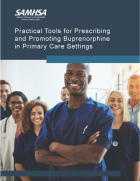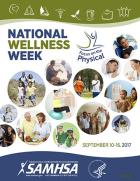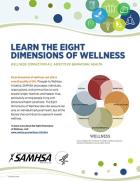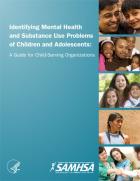Dashboard: Filter Bricks
Main page content

The youth suicide warning note cards are 5”x7” handouts designed to educate about the warning signs for youths and educate about 988.


This 2-sided 3.5"x2" business-sized wallet card helps publicize the 988 Suicide & Crisis Lifeline.

This 2-sided 3.5"x2" business-sized wallet card helps publicize the 988 Suicide & Crisis Lifeline.

This 4.75" by 4.75"-sized magnet helps publicize the new 988 Suicide & Crisis Lifeline phone number and provides access to this life-saving resource in places that are highly visible.

The Safety Plan is a 5”x7” pad, similar to a prescription pad, with 50 sheets of pull off plans. The intended use is for counselors, therapists, clinicians, and others working with people in need of safety plans. It is modified from Stanley & Brown.


This cellphone-shaped magnet (size 3.25"x6") helps publicize the new 988 Suicide & Crisis Lifeline phone number and provides access to this life-saving resource in places that are highly visible.

This 18x24 inch poster helps publicize the new 988 Suicide & Crisis Lifeline and provides access to this life-saving resource. This poster is designed to be placed in schools, community centers, counseling offices, clinics, and other settings where people gather.


This resource provides information to primary care providers and practices on how to implement opioid use disorder treatment using buprenorphine. It identifies common barriers and strategies to overcome them. It documents step-by-step tactics to support buprenorphine implementation.

This guide reviews ways that telehealth modalities can be used to provide treatment for serious mental illness and substance use disorders among adults, distills the research into recommendations for practice, and provides examples of how these recommendations can be implemented.

This guide will help families who have a loved one who is suicidal or has made a suicide attempt. It will provide information on understanding suicide, warning signs and action steps to take, and how to prevent future attempts and keep your loved one safe.

This Advisory, based on TIP 49, Incorporating Alcohol Pharmacotherapies Into Medical Practice, focuses on medication and related treatment decisions made after screening and assessment for AUD, and medically supervised withdrawal, if necessary. Alcohol consumption should not stop abruptly in those patients who have consumed alcohol regularly over a prolonged period of time. This Advisory is meant as an overview of AUD medications to facilitate abstinence.

This brochure offers emergency department providers tips for enhancing treatment for people who have attempted suicide. It also offers information about communicating with families, HIPAA, patient discharge, and resources for medical professionals, patients, and their families.

A component of SAMHSA's Wellness initiative, this poster emphasizes "Focus on the Physical," and shows a variety of images of people living a healthy lifestyle such as exercising, sleeping, getting routine checkups, etc.

Anima Promueve a que los profesionales de la salud médicos que brinden serviciosa las personas con trastornos de salud mental, servicios que se enfoquen en sus necesidades. Ofrece datos Brinda hechos sobre los trastornos mentales, indican las ocho dimensiones del bienestar, y brinda consejos para colaborar con los proveedores de salud mental.


APRENDA SOBRE LAS OCHO DIMENSIONES DEL BIENESTAR (Cartel)
Como parte de la Iniciativa de SAMHSA para el Bienestar, este cartel enumera las ocho dimensiones del bienestar: social, ambiental, física, emocional, espiritual, ocupacional, intelectual y financiera. Promueve la comunicación entre las personas con trastornos de salud mental, los profesionales y los proveedores de salud. Tamaño del cartel 24 x 18 pulgadas (aproximadamente 61 x 46 cm).

Explica a los consumidores lo que es el bienestar y cómo afecta a la calidad de vida en general, sobre todo para las personas con trastornos de salud mental. Describe las ocho dimensiones del bienestar y ofrece sugerencias sobre cómo las personas pueden aplicarlas a su propia vida para mejorar su bienestar general.

This document explains to consumers the importance of wellness and how it affects overall quality of life, particularly for people living with mental illness. It also gives a brief overview of the eight dimensions of wellness: social, environmental, physical, emotional, spiritual, occupational, intellectual, and financial.

A component of SAMHSA's wellness initiative, this poster encourages mental health consumers, professionals, and primary care providers to communicate about overall wellness. The poster presents a diagram of the eight dimensions of wellness: social, environmental, physical, emotional, spiritual, occupational, intellectual, and financial. The poster comes folded and is 24 inches x 18 inches.

Lists questions consumers can ask themselves to help them decide whether to seek help for a substance abuse problem, a mental health issue, or both. Urges those who answered "yes" to any of the questions to seek help and lists resources for more information.

This fact sheet encourages clinicians to provide consumer-centered care to people living with mental illness. It provides facts about mental health issues and lists the eight dimensions of wellness. The fact sheet includes strategies for providing care and connecting with a patient's mental health provider.

This fact sheet recognizes wellness as an important part of recovery and notes its value in reducing morbidity and mortality among people living with mental illness. It explains the eight dimensions of wellness and how these dimensions impact overall health.

This brochure lists questions to ask yourself to help decide whether to seek help for mental illness, substance use disorders, or both. It urges people who answer "yes" to any of the questions to seek help and provides resources for more information.

For individuals at risk of suicide, primary and behavioral health care settings provide unique opportunities to connect with the health care system and access effective treatment. Suicide Safe is a free mobile app that helps providers integrate suicide prevention strategies into their practice and address suicide risk among their patients. The Suicide Safe app is based on SAMHSA's Suicide Assessment Five-Step Evaluation and Triage (SAFE-T) card.
With Suicide Safe, primary and behavioral health care providers can:
- Learn how to use the SAFE-T approach when working with patients.
- Explore interactive sample case studies and see SAFE-T in action through case scenarios and tips.
- Quickly access and share information, including crisis lines, fact sheets, educational opportunities, and treatment resources.
- Browse conversation starters that provide sample language and tips for talking with patients who may need suicide intervention.
- Locate treatment options, filter by type and distance, and share locations and resources to provide timely referrals for patients.
For more information, email SAMHSA at samhsainfo@samhsa.hhs.gov.

This report summarizes the clinical and cost effectiveness of crisis services. It also presents case studies of approaches states are using to coordinate, consolidate, and blend funding sources to provide robust crisis services.

Lists questions consumers can ask themselves to help them decide whether to seek help for a substance abuse problem, a mental health issue, or both. Urges those who answered "yes" to any of the questions to seek help and lists resources for more information

Lists questions consumers can ask themselves to help them decide whether to seek help for a substance abuse problem, a mental health issue, or both. Urges those who answered "yes" to any of the questions to seek help and lists resources for more information

Lists questions consumers can ask themselves to help them decide whether to seek help for a substance abuse problem, a mental health issue, or both. Urges those who answered "yes" to any of the questions to seek help and lists resources for more information.

In a disaster, it's essential that behavioral health responders have the resources they need—when and where they need them. The free SAMHSA Disaster App offers first responders immediate access for any type of traumatic event at every phase of response, including pre-deployment preparation, on-the-ground assistance and post-deployment resources.
With the SAMHSA Disaster App, first responders can:
- Access resources including tip sheets; guides for responders, teachers, parents, and caregivers; and a directory of behavioral health service providers in the impacted area.
- Download information on your phone before deployment in case of limited Internet connectivity in the field.
- Review key preparedness materials to help you provide the best support possible.
- Send information to colleagues and survivors via text message, email, or transfer to a computer for printing.
- Find interventions to help survivors of infectious disease epidemics.
Find SAMHSA’s disaster response information as a publication. Download the SAMHSA Disaster Kit.
For more information, email SAMHSA at samhsainfo@samhsa.hhs.gov

This manual provides clinical practice guidelines for using medications in the medication-assisted treatment of alcohol use disorder. It offers guidance on prescribing acamprosate, disulfiram, oral naltrexone, and extended-release injectable naltrexone. The manual also discusses patient management. Access the literature review.

This manual guides clinicians through stages of primary care for alcohol and substance misuse in adult patients. It discusses warning signs of misuse, screening and follow-up, brief intervention, assessment, treatment models, and legal issues. It includes four screening tools.

This guide highlights behavioral health challenges facing veterans who have served in Afghanistan and Iraq. It presents challenges related to substance misuse, post-traumatic stress disorder, depression, and suicide. The guide also discusses screening tools and intervention.

This advisory answers questions about the seriousness of prescription drug misuse. It explains how people become dependent on prescription drugs, and treatment options. The advisory also offers necessary treatment resources for professionals.

This manual offers guidance to clinicians on implementing drug testing in their practice. It presents the mechanics of testing and outlines steps for preparing staff.

This manual offers guidance and tools for identifying mental illness or substance use issues early in children and adolescents in various setting, such as in schools, the juvenile justice and child welfare system, and when receiving primary care.

This guide provides clinicians with questions to begin discussions with adult patients about mental illness, substance use disorders, or both. It includes resources for patients who need an evaluation after a positive screening.

This manual guides counselors in the use of medications to help clients achieve abstinence from alcohol. It describes how the medications work and whom may benefit. It also presents the side effects of three FDA-approved medications: acamprosate, disulfiram, and naltrexone.

This resource gives a brief overview on conducting a suicide assessment using a five-step evaluation and triage plan. The five-step plan involves identifying risk factors and protective factors, conducting a suicide inquiry, determining risk level and interventions, and documenting a treatment plan. Suicide Safe mobile app based on the SAFE-T is available on the app stores. Download SAMHSA's Suicide Safe mobile app on your mobile device.

This brochure explains the Crisis Counseling Assistance and Training Program's emergency mental health services and programs for people who have experienced traumatic events. It helps states, territories, and federally recognized tribes prepare grant applications for funding.

This toolkit offers tools to implement the evidence-based practice of Assertive Community Treatment (ACT). ACT offers customized, community-based services for people living with mental illness. The toolkit includes a brochure (English, Spanish), a PowerPoint presentation, and an introductory video.

This white paper report identifies and proposes strategies to address Medicaid and other reimbursement policies that may pose barriers to mental health services in primary care settings. It presents findings, discussion by an expert panel, and recommended action steps.

This wallet card lists signs of depression. It urges people to call the National Suicide Prevention Lifeline if they or someone is having trouble coping after a traumatic event.

Esta tarjeta para la cartera lista las señales de alerta de depresión y de pensamientos y comportamientos suicidas que se pueden presentar en las victimas del desastre. Aparece el numero telefonico gratis de la Red nacional para la prevencion del suicidio.

This manual helps mental health professionals build an emergency preparedness program in response to mass violence and terrorism. It includes background information, key concepts in mental health intervention, and guidance for setting up a training course.

